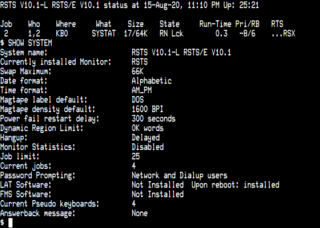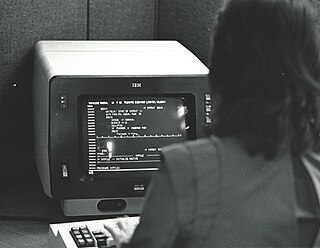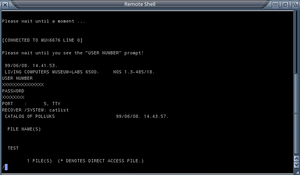
A shell script is a computer program designed to be run by a Unix shell, a command-line interpreter. The various dialects of shell scripts are considered to be scripting languages. Typical operations performed by shell scripts include file manipulation, program execution, and printing text. A script which sets up the environment, runs the program, and does any necessary cleanup or logging, is called a wrapper.
Computerized batch processing is a method of running software programs called jobs in batches automatically. While users are required to submit the jobs, no other interaction by the user is required to process the batch. Batches may automatically be run at scheduled times as well as being run contingent on the availability of computer resources.

The CDC 6600 was the flagship of the 6000 series of mainframe computer systems manufactured by Control Data Corporation. Generally considered to be the first successful supercomputer, it outperformed the industry's prior recordholder, the IBM 7030 Stretch, by a factor of three. With performance of up to three megaFLOPS, the CDC 6600 was the world's fastest computer from 1964 to 1969, when it relinquished that status to its successor, the CDC 7600.
OS/8 is the primary operating system used on the Digital Equipment Corporation's PDP-8 minicomputer.

RSTS is a multi-user time-sharing operating system developed by Digital Equipment Corporation for the PDP-11 series of 16-bit minicomputers. The first version of RSTS was implemented in 1970 by DEC software engineers that developed the TSS-8 time-sharing operating system for the PDP-8. The last version of RSTS was released in September 1992. RSTS-11 and RSTS/E are usually referred to just as "RSTS" and this article will generally use the shorter form. RSTS-11 supports the BASIC programming language, an extended version called BASIC-PLUS, developed under contract by Evans Griffiths & Hart of Boston. Starting with RSTS/E version 5B, DEC added support for additional programming languages by emulating the execution environment of the RT-11 and RSX-11 operating systems.

The CDC Cyber range of mainframe-class supercomputers were the primary products of Control Data Corporation (CDC) during the 1970s and 1980s. In their day, they were the computer architecture of choice for scientific and mathematically intensive computing. They were used for modeling fluid flow, material science stress analysis, electrochemical machining analysis, probabilistic analysis, energy and academic computing, radiation shielding modeling, and other applications. The lineup also included the Cyber 18 and Cyber 1000 minicomputers. Like their predecessor, the CDC 6600, they were unusual in using the ones' complement binary representation.
The Cray Operating System (COS) is a Cray Research operating system for its now-discontinued Cray-1 (1976) and Cray X-MP supercomputers. It succeeded the Chippewa Operating System, and was the Cray main OS until replaced by UNICOS in the late 1980s. COS was delivered with Cray Assembly Language (CAL), Cray FORTRAN (CFT), and Pascal.

XEDIT is a visual editor for VM/CMS using block mode IBM 3270 terminals.

PRIMOS is a discontinued operating system developed during the 1970s by Prime Computer for its minicomputer systems. It rapidly gained popularity and by the mid-1980s was a serious contender as a mainline minicomputer operating system.

The architecture of Windows NT, a line of operating systems produced and sold by Microsoft, is a layered design that consists of two main components, user mode and kernel mode. It is a preemptive, reentrant multitasking operating system, which has been designed to work with uniprocessor and symmetrical multiprocessor (SMP)-based computers. To process input/output (I/O) requests, it uses packet-driven I/O, which utilizes I/O request packets (IRPs) and asynchronous I/O. Starting with Windows XP, Microsoft began making 64-bit versions of Windows available; before this, there were only 32-bit versions of these operating systems.
Display code is the six-bit character code used by many computer systems manufactured by Control Data Corporation, notably the CDC 6000 series in 1964, the 7600 in 1967 and the following Cyber series in 1971. The CDC 6000 series and their successors had 60 bit words. As such, typical usage packed 10 characters per word. It is a six-bit extension of the four-bit BCD encoding, and was referred to as BCDIC
SCOPE is a series of Control Data Corporation batch operating systems developed in the 1960s.
The CDC 1700 is a 16-bit word minicomputer, manufactured by the Control Data Corporation with deliveries beginning in May 1966.
VS/9 is a computer operating system for the UNIVAC Series 90 mainframes, used during the late 1960s through 1980s. The 90/60 and 90/70 were repackaged Univac 9700 computers. After the RCA acquisition by Sperry, it was determined that the RCA TSOS operating system was far more advanced than the Univac counterpart, so the company opted to merge the Univac hardware with the RCA software and introduced the 90/70. The 90/60 was introduced shortly thereafter as a slower, less expensive 90/70. It was not until the introduction of the 90/80 that VS/9 finally had a hardware platform optimized to take full advantage of its capability to allow both interactive and batch operations on the same computer.
Service in Informatics and Analysis was one of the pioneering time-sharing service bureau companies in the late 1960s, later known as SIA Computer Services. Its head office was located at Lower Belgrave Street, close to Victoria Station in London, and the company had branch offices in Edinburgh, Manchester, the West End, Paris and in Hong Kong. SIA offered terminal services via the Post Office telephone network at speeds of 10, 15, 30, 60 and 120 characters per second for Teletype-style terminals and of 1200 baud, 2400 baud and 4800 baud for Remote Job Entry terminals. Later with the release of the IBM PC, systems were developed to emulate the Remote Batch and interactive terminals. Clients could also visit the head or branch offices to submit their jobs personally or have them accepted and supervised by the production department.
OS 2200 is the operating system for the Unisys ClearPath Dorado family of mainframe systems. The operating system kernel of OS 2200 is a lineal descendant of Exec 8 for the UNIVAC 1108 and was previously known as OS 1100. Documentation and other information on current and past Unisys systems can be found on the Unisys public support website.

MTS System Architecture describes the software organization of the Michigan Terminal System, a time-sharing computer operating system in use from 1967 to 1999 on IBM S/360-67, IBM System/370, and compatible computers.
The Universal Time-Sharing System (UTS) is a discontinued operating system for the XDS Sigma series of computers, succeeding Batch Processing Monitor (BPM)/Batch Time-Sharing Monitor (BTM). UTS was announced in 1966, but because of delays did not actually ship until 1971. It was designed to provide multi-programming services for online (interactive) user programs in addition to batch-mode production jobs, symbiont (spooled) I/O, and critical real-time processes. System daemons, called "ghost jobs" were used to run monitor code in user space. The final release, D00, shipped in January, 1973. It was succeeded by the CP-V operating system, which combined UTS with features of the heavily batch-oriented Xerox Operating System (XOS).
NOS/VE is a discontinued operating system with time-sharing capabilities, written by Control Data Corporation in the 1980s. It is a virtual memory operating system, employing the 64-bit virtual mode of the CDC Cyber 180 series computers. NOS/VE replaced the earlier NOS and NOS/BE operating systems of the 1970s.
The Hazeltine 2000 is one of the first general-purpose "smart" computer terminals, introduced in October 1970 at a price of $2,995. While earlier terminal systems included "smart" editing features, notably the IBM 2260, the Hazeltine 2000 was the first that used a standard RS-232 interface and sent its control sequences in the data stream. It could be attached to any contemporary minicomputer or mainframe that had a serial port and used ASCII-standard character sets.











